Attending a workshop can be one of the most productive ways to push your photography to new heights. f-stop Ambassador Erin Babnik runs workshops in stunning locations that read like a bucket list of picturesque places to visit for landscape photography. We caught up with Erin to hear about her path into photography, what it takes to run these workshops, and her pick of essential gear to bring to a workshop.

Can you tell us a little about yourself, and how you got into photography?
Immersion in the visual arts has been the one constant in my life, including extensive formal education in various studio arts, graphic design, and in the history of art. Before I decided to pursue my photography career full-time, I was an art historian specializing in ancient Greek art. I needed to produce photographs for my dissertation and also for the classes that I was teaching while I was in graduate school, so it was then that I first began to travel widely with camera equipment. I photographed thousands of artworks inside museums and went to great lengths to photograph archaeological sites all around Europe and in the Middle East, which was expensive and time-consuming. I eventually started funding my trips and equipment upgrades by getting into stock photography and assignment work.
As I began devoting more of my time and resources to improving the quality of my photographs, it became increasingly clear to me that photography was capturing my imagination and my heart. I was still very passionate about art history, but I knew that I had found an even more inspiring calling that needed to be a larger part of my life. Craving more immersive and creative experiences, I began going on photography trips into wilderness areas, far from any of the cultural treasures that had always given me a reason to use my camera. During my college years I had drifted away from the outdoors activities that had been a great source of enjoyment for me earlier, so returning to wilderness areas with photography in mind became a major tipping point in my life. I could not get enough of it, and I finally admitted to myself that I was on course to a career change.
The idea of leaving academia was very difficult for me and only became a serious plan when I realized that I would be able to retain everything that I truly enjoyed about it. As a photographer, I would still be able to teach, to write, to lecture, to travel widely, and to draw upon my formal education in art and art history. Teaching photography workshops brings all of these interests together for me at once, which is why I have made teaching a focus of my career as a full-time landscape photographer.

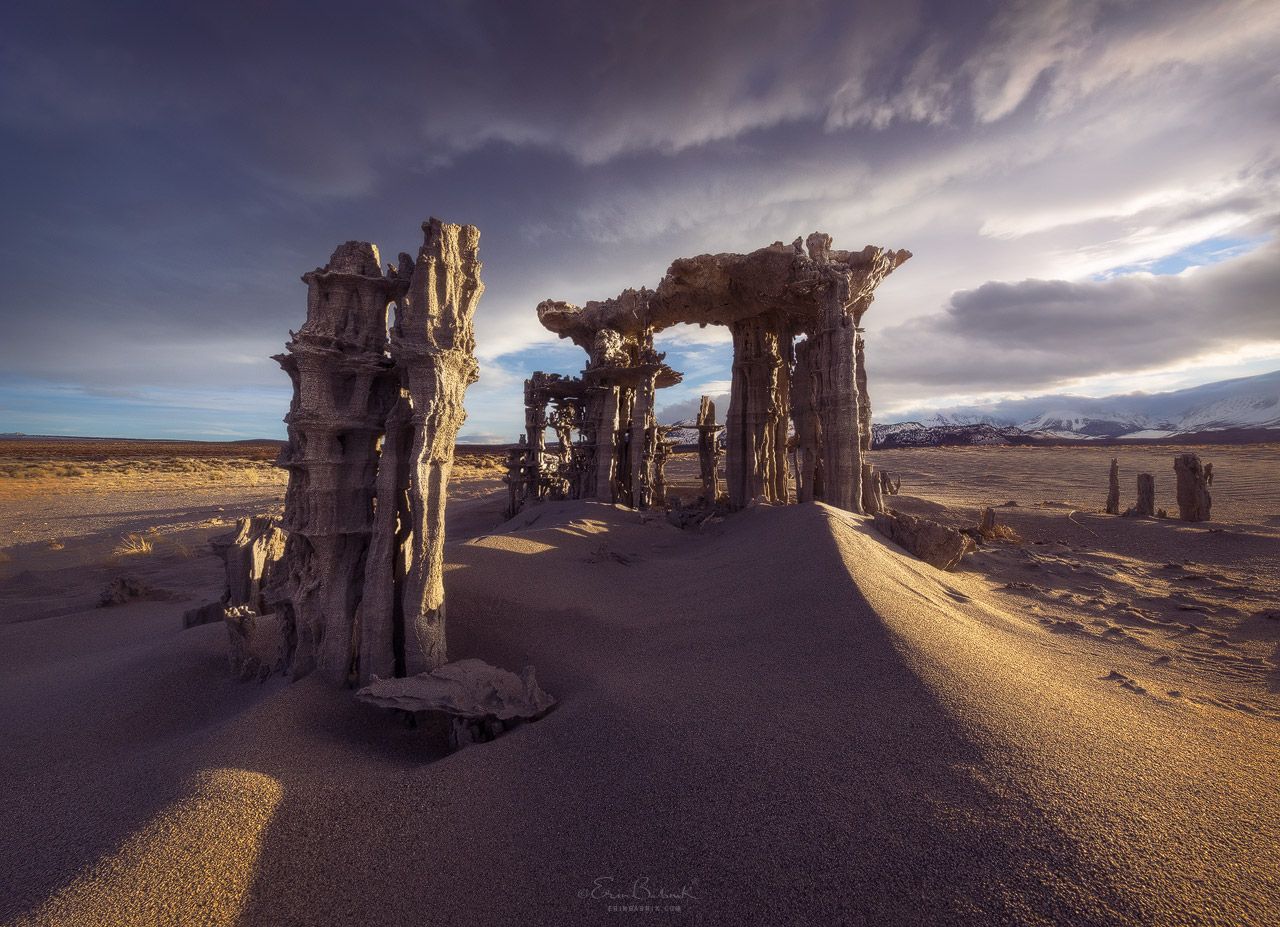
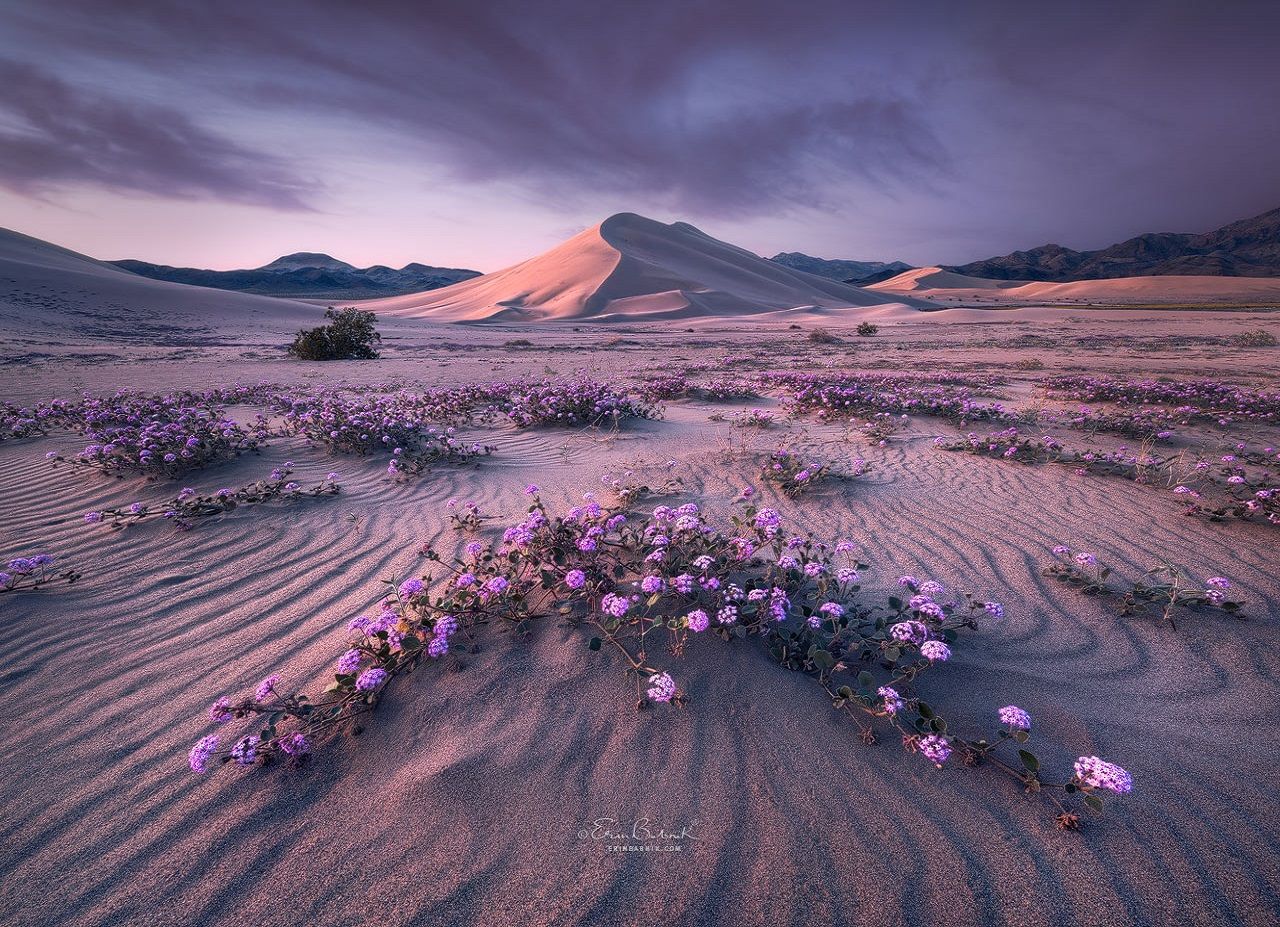
Your talks and articles have made you one of the most notable voices among the current generation of landscape photographers; can you tell us a bit more about how you bring your ideas about photography to the workshop experience?
The ideas that I express in my writing and public speaking become a part of the workshop experience in a variety of ways. Most directly, they come out in the seminars that I schedule into most of my workshops to supplement the in-field instruction. Depending on the length of the workshop and the location, I include anywhere from one to four creativity seminars in addition to my usual post-processing instruction sessions. The topics vary, but they have included seminars on composition, on the history of landscape photography, on the creative process, and on portfolio development. I first started integrating these seminars into my masterclass series, and they were hugely successful, so now I have made them a regular part of my teaching programs.
The other outlet that I have for sharing these ideas is through impromptu discussions with students during the course of a workshop. Many of my workshop participants have questions about articles that I’ve written or else ask questions that relate to what I’ve written, and the resulting conversations tend to be enormously productive. I really enjoy discussing all aspects of photography and its relation to other arts, and it is always very rewarding to hear that my students have found these discussions helpful and inspirational.

Like all things in life, there must be some challenges while planning a workshop. What do you see as the biggest challenges to delivering a successful workshop?
Logistics probably present the most challenging problems to solve when planning a workshop. In order for everything to run smoothly, I have to consider a huge range of issues that all need to work together: where we go, what conditions to target, how we will get there, when and where people will eat and sleep, how much physical activity the average person can handle in an outing and how they might feel the next day, how much everyone can carry, and how to store what they cannot carry. I invest an enormous amount of time into planning a workshop in order to ensure that everyone has a great time and is able to make the most of the photographic opportunities and instruction.

You've been to some stunning places to shoot. How do you pick your locations for workshops?
Most of my workshops feature unique locations that I discovered through my own exploration, in combination with locations pioneered by some of my co-leaders, and also with a few classic areas included. I try to choose locations that are not only highly photogenic but that offer a good range of options for being creative. Even the more classic areas that I feature are of this sort, such as the Mesquite Sand Dunes in Death Valley, an area that has been highly photographed for decades and yet provides endless opportunities for photographers to create unique and rewarding photographs. My extensive exploration of the Dolomites has turned up dozens of locations where my students can experiment with a variety of focal lengths and compositional styles all in one spot, making my Dolomites workshop series extremely popular. Not only do my workshop participants appreciate such versatile locations, but I am able to stay inspired myself by returning to these areas that always seem to have something new to offer.
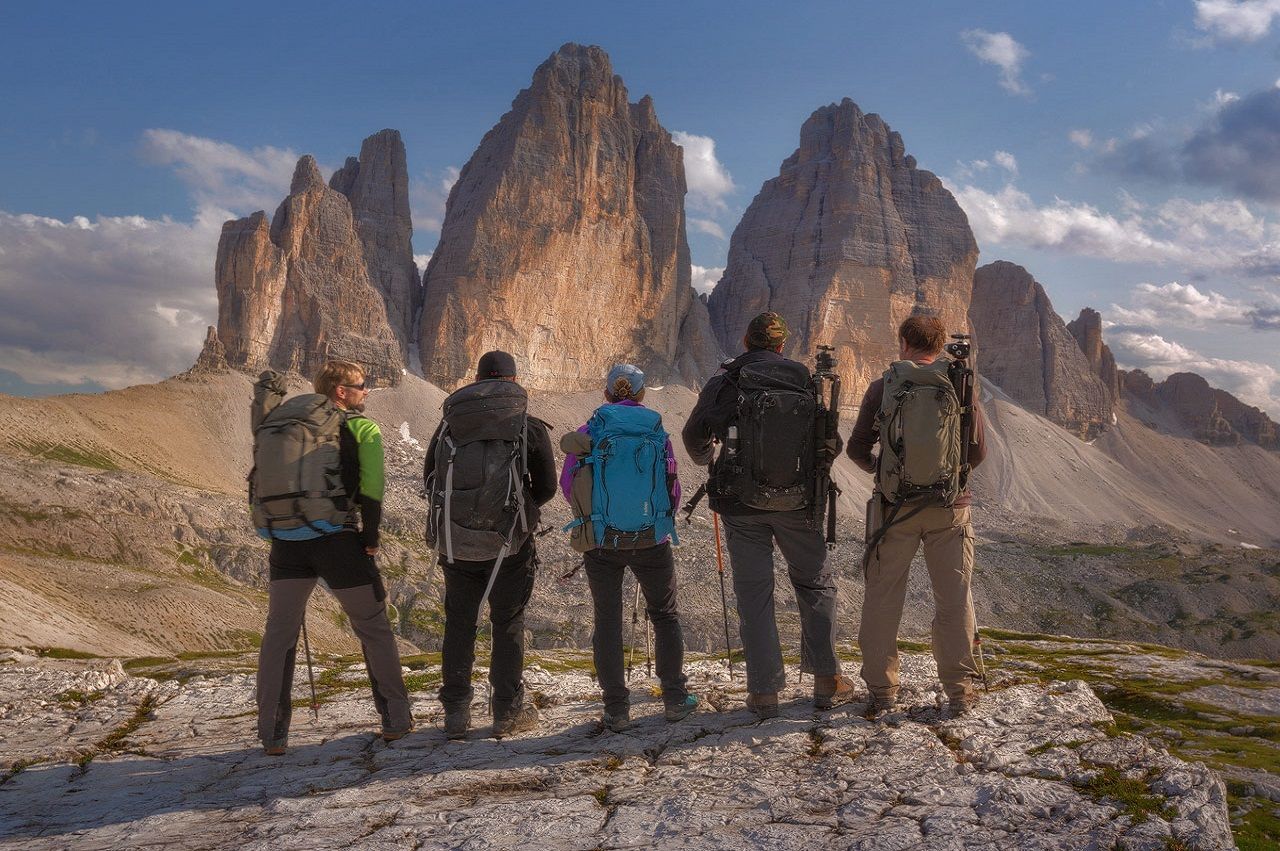
For participants coming to shoot in those locations, what are your top picks of essential items that they should pack or bring?
Because my workshops are based in wilderness areas, we are usually doing some walking or hiking to reach them. A walk might be anywhere from fifteen minutes to two hours long, depending on the workshop, but regardless we are not usually right next to any vehicles or buildings and therefore need to carry whatever we will need to use while we are out in the field. A good photo backpack is therefore an absolutely essential item, and I always recommend that participants bring one that can carry more than just their camera gear and that stands up well to the elements and to whatever rocks or damp surfaces may be beneath a backpack when it is on the ground. For those workshops where we are backpacking to mountain huts or are even just doing longer day hikes, I also consider trekking poles to be essential items because they make the hiking much easier and improve balance on uneven terrain. Of course there are a lot of standard items that I recommend in addition, such as a tripod, a headlamp, and protective clothing, but the choice of a good backpack and trekking poles makes it easier to carry all of those items comfortably and safely. Aside from these essentials, I always advise my participants to bring their spirit of adventure!
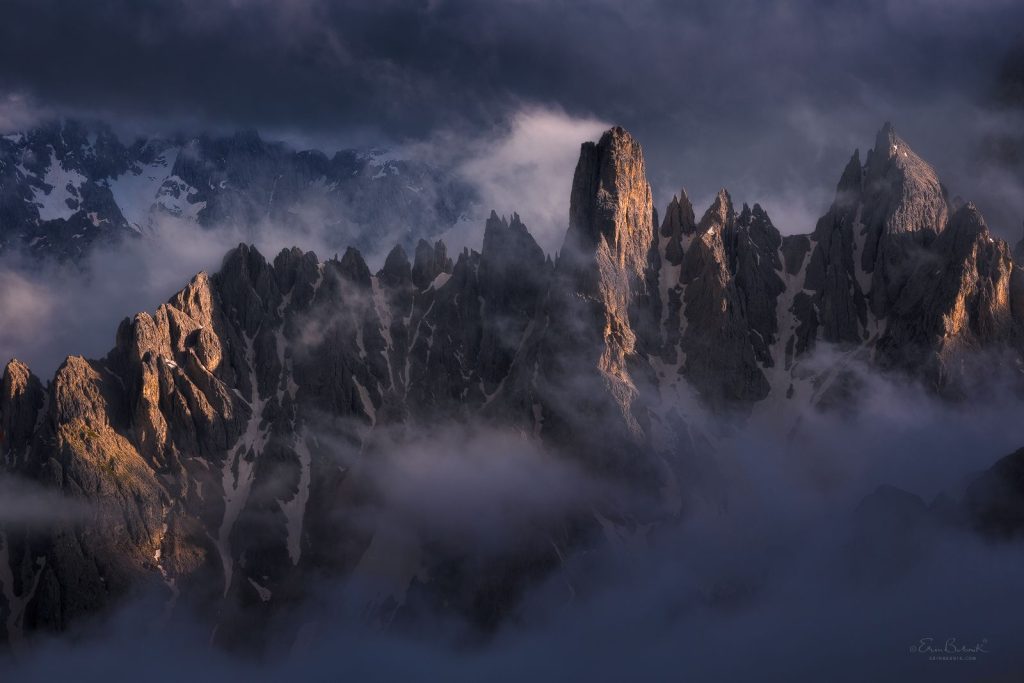
Every year Red Bull Rampage produces some of the most jaw-dropping images of mountain biking. f-stop Icon Scott Markewitz breaks down his gear and talks us through what is going in his bag for the Red Bull Rampage, along with some shots taken with that setup over the years.
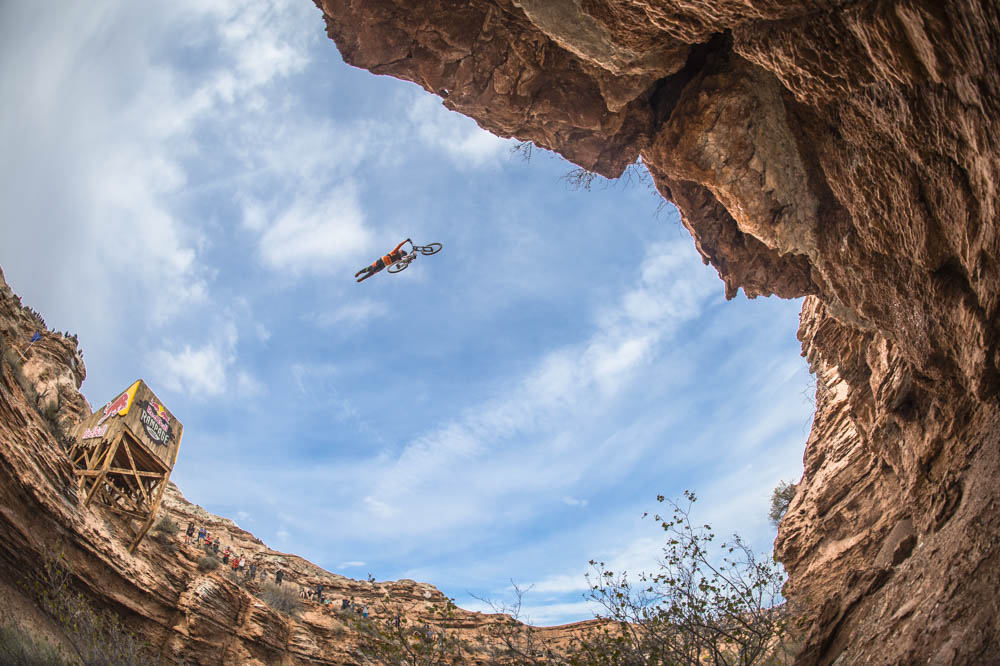
Words and photos: Scott Markewitz
In 2018 f-stop Icon Scott Markewitz documented the Red Bull Rampage as the Event also moved to a new zone with riders building entirely new features and lines. Just like the riders, the photographers have to navigate the vertigo-inducing terrain to find their angles on these new features. In order to navigate the Rampage course and still carry a two-body setup, Scott grabs the slimmest of the Mountain Series packs for this.
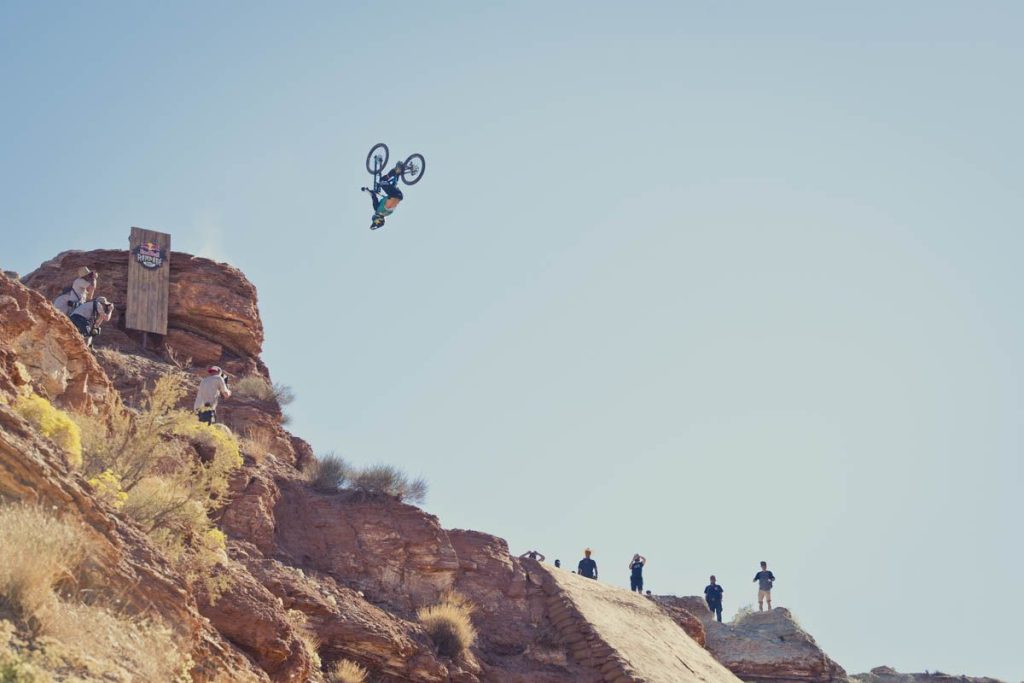
Kurt Sorge sends a backflip over the media pack at last year's Rampage, shot with the trusty 70-200.
The Rampage is one of the most incredible events in action sports. It brings together the world’s best freeride mountain bikers for a contest and a show of massive jumps and insane riding skills on the rugged terrain around Virgin, Utah. I’ve been to every Rampage since the beginning and it’s definitely one of the shoots I look forward to every year
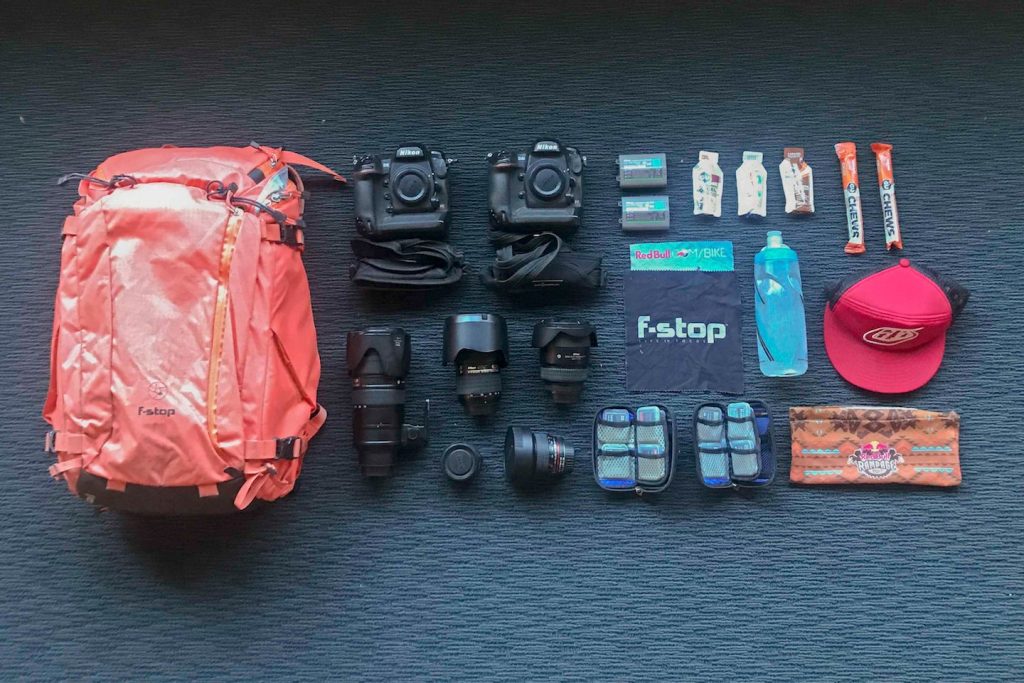
On the road to Rampage 2018: Packing two full frame pro body DSLRs, 4 lenses, and daily essentials in the 32L Lotus camera bag to stay agile working shooting among the Utah cliffs of the Red Bull Rampage course.
One of the challenges of photographing the Red Bull Rampage is moving around and getting set up to shoot the riders during the event. The venue is spread out and every athlete takes a different line down the mountain. There’s not much time between runs, so you have to have to know where you’re going to shoot and move fast between each run to get in place. I like to have a pack that is large enough to carry everything I need for the event but light and agile when I’m running up and down the mountain between shots. For this year’s Rampage, I’m taking a Lotus.
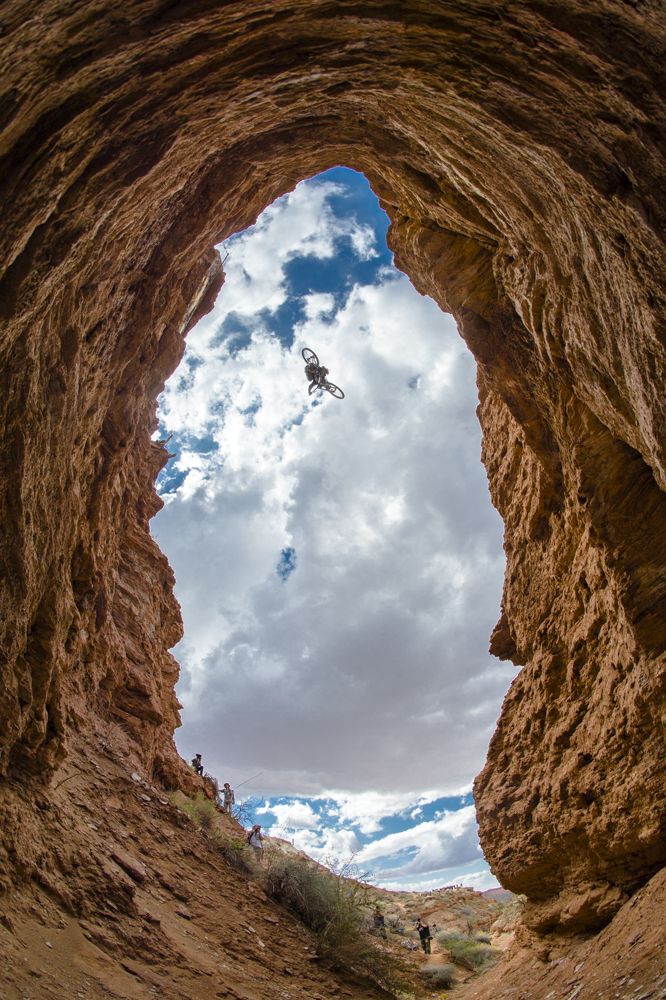
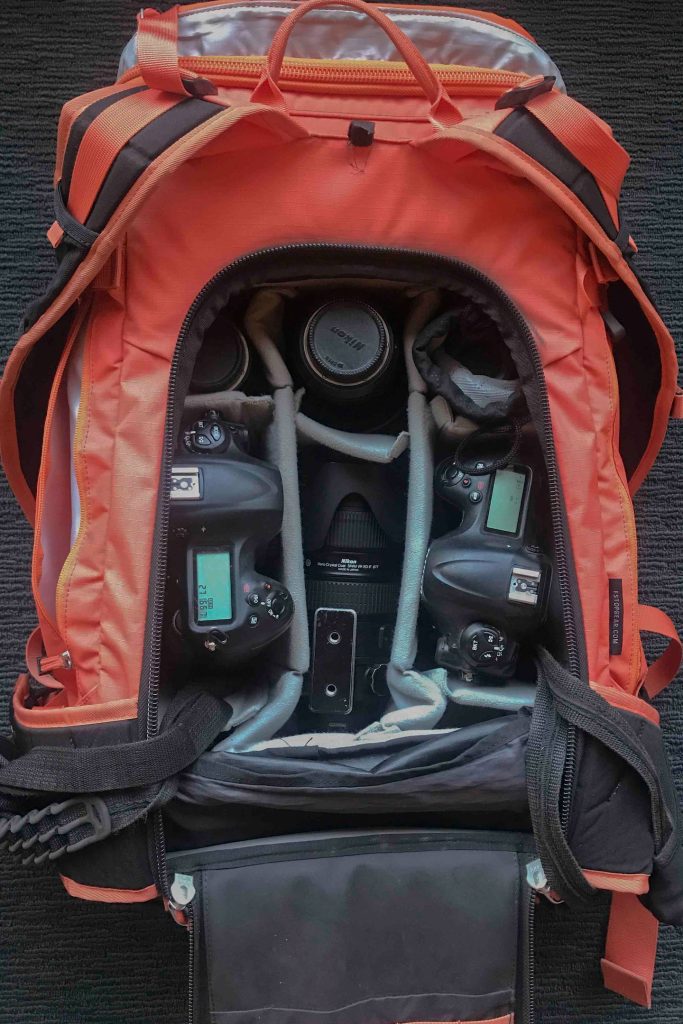
The Lotus is a great mid-size camera pack that still fits a Large Pro Camera Insert but is lightweight and most importantly easy to move around with. This is especially important on an Event like the Red Bull Rampage.
I always have two full-size DSLR bodies in my camera backpack, a Nikon D5 for the majority of my work with a Nikon D4S as a backup just in case the D5 fails. For lenses, I bring a 70-200mm 1:2.8 GII, 24-70mm 1:2.8G, 17-35mm 1:2.8D, 12mm 2.8 Fisheye, a 1.4x converter to extend the range of my 70-200, as well as extra camera batteries, lens cloths and more than enough CF cards for any day of shooting.

Cam Zink doing what most of us would want a parachute for, on his way to 2nd place at Rampage 2017, shot with the 12mm fisheye giving a sense of the wide open space the athlete is launching into.
The Southern Utah desert is hot, dry, and dusty and the sun beats down on you when you’re out there all day. A water bottle is obviously important to stay hydrated, but I also bring a hat, a buff for extra cover, and sunblock (not shown), as well as a few GU energy gels and chews for a quick energy boost when I need it.
It doesn’t seem possible that the riders can go any bigger or do anything wilder, but at every Rampage the athletes continue to push the realm of what’s possible to new levels. I’m really excited to see what they are going to pull off in the future.
It’s going to be another incredible event!
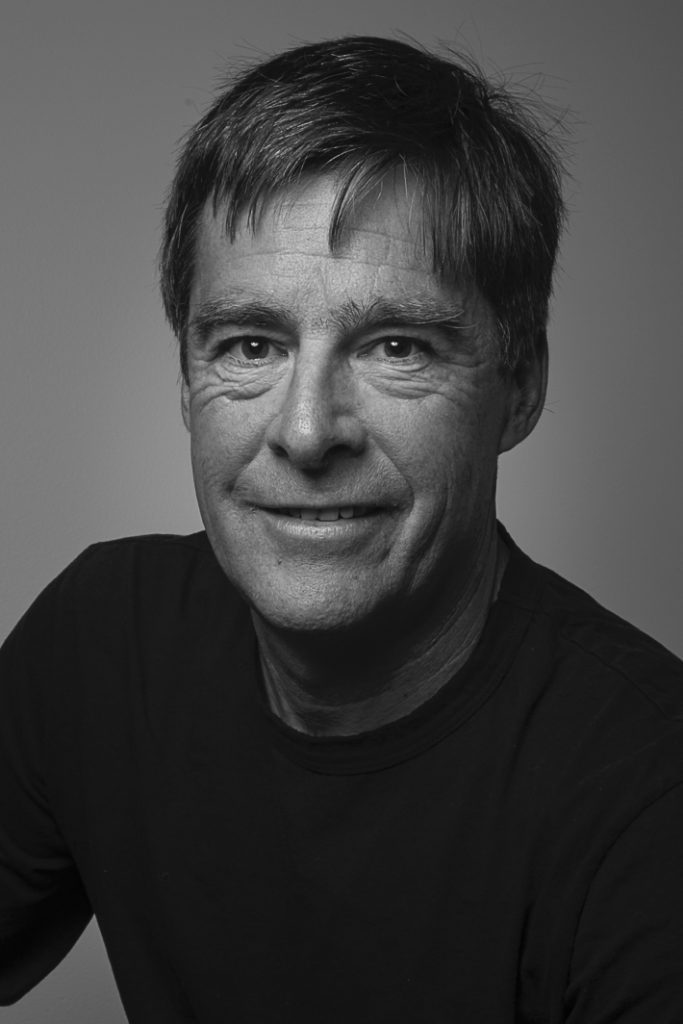
Scott Markewitz is recognized as one of the most influential outdoor photographers in the industry. His passion for photography and the outdoors comes through in everything that he shoots, whether it’s action sports, active lifestyle, or environmental portraits. His images have appeared in advertising and promotional campaigns for many well-known outdoor and consumer brands
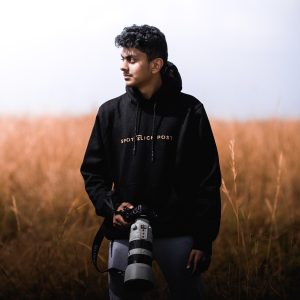
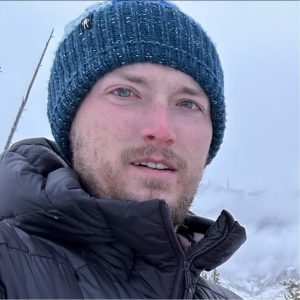
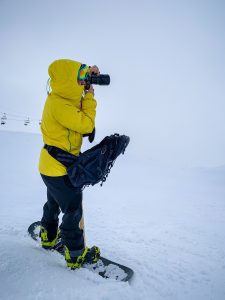
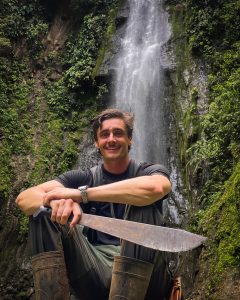
f-stop Global Icon Tsutomu Endo traded up the mountains of his native Japan for the wild open spaces of Alaska last spring. He undertook a road trip across Alaska with the goal of meeting up with a small community of snowboarders forging a snowboarding lifestyle far away from ski resorts. He took the FUJIFILM X-Pro2, a camera more commonly associated with artistic landscape and street photography, to capture both the snowboard action and document the tight-knit community dedicated to this lifestyle.
This video shows his trip in all its glory, and we caught up with Tsutomu to hear a bit more about the trip and the gear he used in the deep snow of 'the last frontier':
What was the photographic goal of your trip to Alaska?
The goal of this trip was to shoot a documentary of the life of snowboarders in Alaska. Of course, that also included shooting action of their hardcore backcountry snowboarding too.
What connection took you from Japan to this remote area of Alaska?
My good friend Ryland Bell is a professional snowboarder from Alaska. He came over to Japan to ride, and we shared so many good times in and around my home mountains in Japan. Through that experience we became good friends, so this trip was also kind of about exchange and friendship. Ryland had been immersed in the Japanese scene, and I was interested to taste Alaskan life and check out the mountains there. Ryland is part of a small community of snowboarders based in Haines.
Riding snowmobiles and hiking deep into wild mountains of Alaska to get shots snowboarders is far from most people’s daily shooting routine. What were the biggest challenges of that?
There are no ski resorts out there in that area. More than shooting, it’s just super tough to go snowboarding there at all. It needs team work and lot of energy. To navigate through that terrain by snowmobile as a group you have to build a good relationship of trust. But in that, you can feel their human passion in the wild snow-covered mountain landscape.
What gear do you use for getting the shot in the mountains?
I have been trying out the Fujifilm X-Pro2 for extreme mountain shooting recently. The camera is very light and compact, which makes it very good for hiking and accessing hard-to-reach environments and documentary shooting.
Do you switch up your camera for the landscape and portraits, when you are off the mountain?
No, I was using the x-pro2 for both action and documentary. I switched up the lenses depending on the type of shooting. For portrait and documentary shots I used Fuji primes, XF23mm f2 and XF50mm f1.2. Shooting the snowboarding, I used the XF16-55 f2.8 and XF50-140 f2.8 which are both weather sealed.
Even though you were going to shoot snowboarding in Alaska, the journey to get there was a big part of this trip. How was the road trip experience?
To be honest, being on the road travelling was pretty normal for me, as I’m always traveling a lot! But driving through Alaska like that, in the middle of that natural environment you can feel how small humans are in relation to nature, and you are not above any of the animals you meet. You should go!
Alaska seems so big and wild, and you called the snowboarders there in Alaska a “tribe”, which sounds more like nature and wildlife photography than action sports. Did you feel like you were focusing on the snowboarding or the lifestyle more?
Yes. To be a snowboarder is just one of the choices that a human can make for their lifestyle on this earth. We have so many choices about what kind of lifestyle we want to lead. But in Alaska they have not so many. In that environment, it’s usually just survival - fishing and hunting. I think they are in a unique position, where that lack of options becomes a positive, and they able to follow their passion to snowboard in the huge landscape of Alaska.
Where do you want to make your next trip to?
I am thinking about going to the Arctic next, to record the effects of climate change and global warming. In the mountains, I’ve been interested in the reducing size of glaciers, and the Arctic is where those changes seem to be most apparent.
Thanks for taking the time to talk with us, Tsutomu.
Follow more of Tsutomu Endo's FUJIFILM adventures on his X-Photographer page here. You can see more of his work from the North Japanese Alps and his travels on his website here:
Ever since his first skydive, f-stop Staff Pro Jesper Grønnemark had the idea of doing a photo shoot while in the air. This is how it went. Even though as he says, his first skydive was more than enough for him, this idea remained stuck in his mind.
The idea became a reality when Jesper teamed up with the guys from Flux Freefly, gave them a Profoto B1X, and jumped out of an airplane at 13,200 feet to take his photography to new heights.
His heart is racing, adrenaline is gushing into his veins as the door of the airplane opens. 13.200 ft. (4 km) under him the ground stares back. This is it, one chance, one shot. His grip on the Sony A7R II tightens as they move out the side of the plane, 45 seconds of free fall awaits, 3, 2, 1…
FLUX: Benjamiin Laudrup, Jacob Lundsgaard Madsen and Emil Landeværn Kristensen; Head of the project: Michael Boe Laigaard; Lights: Profoto; Camera equipment: Sony Nordic; Video: Kasper Sveistrup - Frame2film; Graphics: Niels Borup - Saftig; Article: Kira Andersen; Pilot: Fillip Højlund Aarhus skydive club Red Bull Denmark
The eternal strive to push the boundaries of what people believe is possible in sports photography has put Jesper Grønnemark in a position he did not imagine himself in again. After his first skydiving experience, some years ago, it wasn´t an immediate love story. Now, here he is again on account of his own creative thinking. Why would he do it again you might ask. Well, the answer is, he needs to. In order to push those boundaries, he is more than willing to put himself in extreme situations.
When trying to capture the emotions of a skydiving experience, safe is not part of the vocabulary.
Jesper Gronnemark
How do you make it happen then? In short, you need a man with a plan, and that man was Michael Boe Laigaard, head of the project in terms of finding the right people, and those people came in the form of the Danish national team in free fly - FLUX.
They are the best when it comes to jumping out of planes and falling controlled through the air. The original plan was that they would all have their parachutes out, Jesper with the camera and Benjamiin with the Profoto B1X flash. It would have been easier to track the skydiver, or Mr. Bill as the “model” is called in skydiving, through the air. However, shortly before the jump, it was deemed too dangerous due to wind and the plan changed to free fall. This new challenge was going to put an even greater demand on Jesper's skills as a sports photographer since they only had one jump and now had to nail the shot in a fall going 200 km/h.
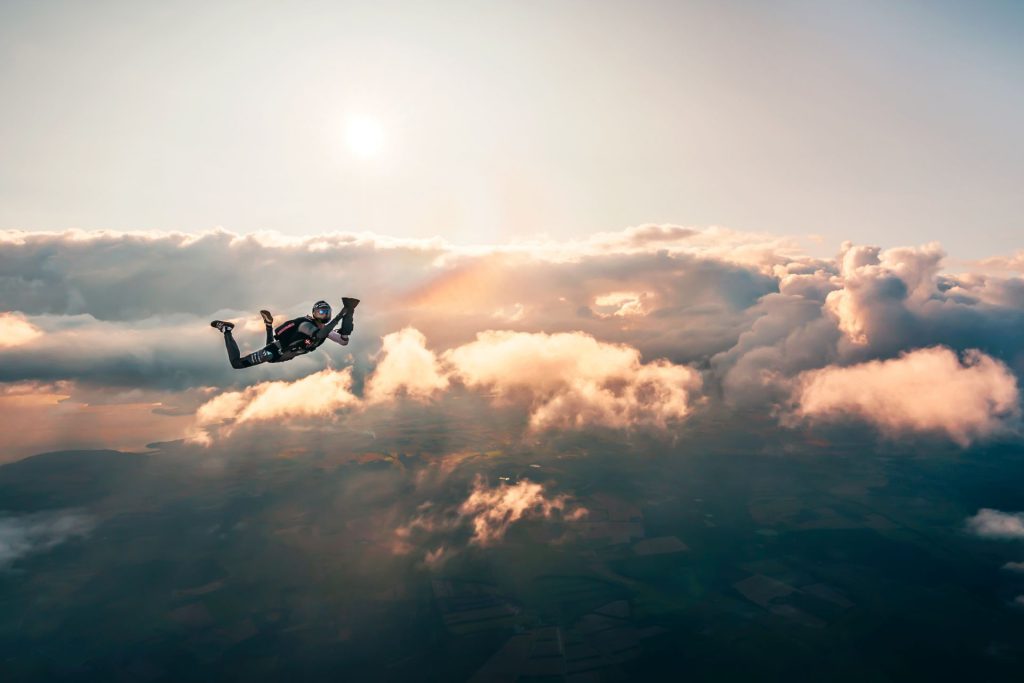
Benjamiin with the Profoto B1X flash
GO! As Jesper is falling through the air, he sees the skydiver approaching from above, he gets his camera in place and suddenly he is cool, calm, and collected. The workflow is such an integrated part of him, that even in a time like this, it overthrows the adrenaline rush. Furthermore, he only has one shot, so he better make it count! The skydiver is head down, shots are fired, and not long after it parachutes out and a touchdown. Fingers are crossed on all parts. How did it turn out?
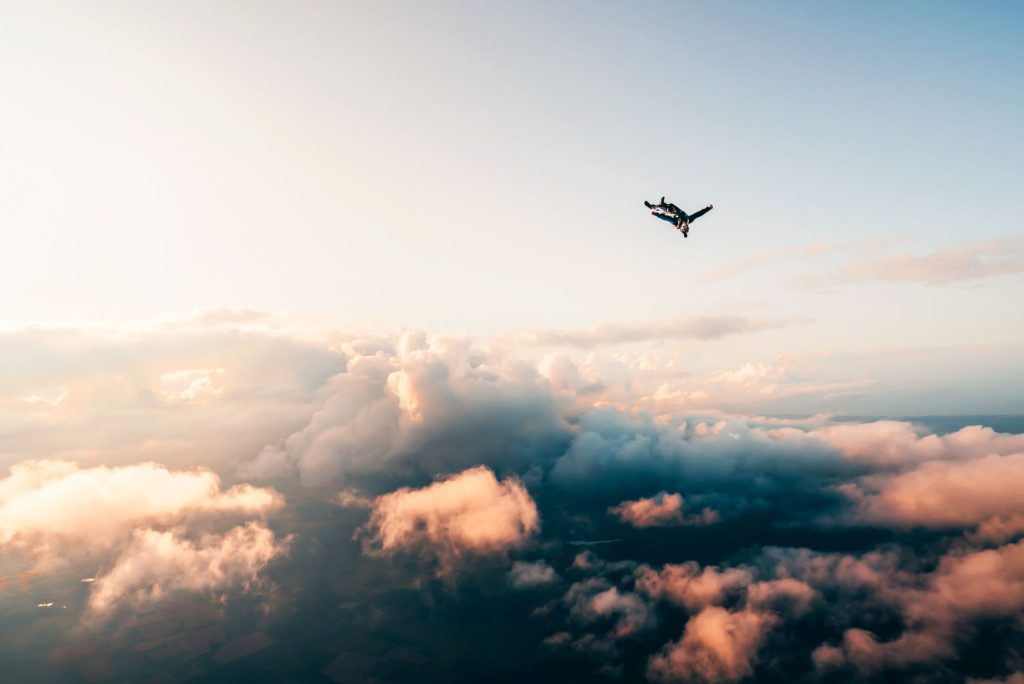
Emil approaches and gets into position for the desired skydiving photo
I only have one Shot, One Jump..and that's it. Once I got my camera to my face while flying through the air at 200 km/h, I was focused. There was no sound, no sense of falling and I didn't feel @michaelboelaigaard on my back.
My only mission was to get the shot!
Jesper Grønnemark
Once again Jesper proves that hard work and quite a bit of sacrifice pays off. A lot of planning went into this shoot and even so, they changed. However, it was for the best. Jesper got the image he originally envisioned! A man hanging in the air above the clouds, head down. It feels as if it would be safer if his head was up, but when trying to capture the emotions of a skydiving experience, safe is not part of the vocabulary.
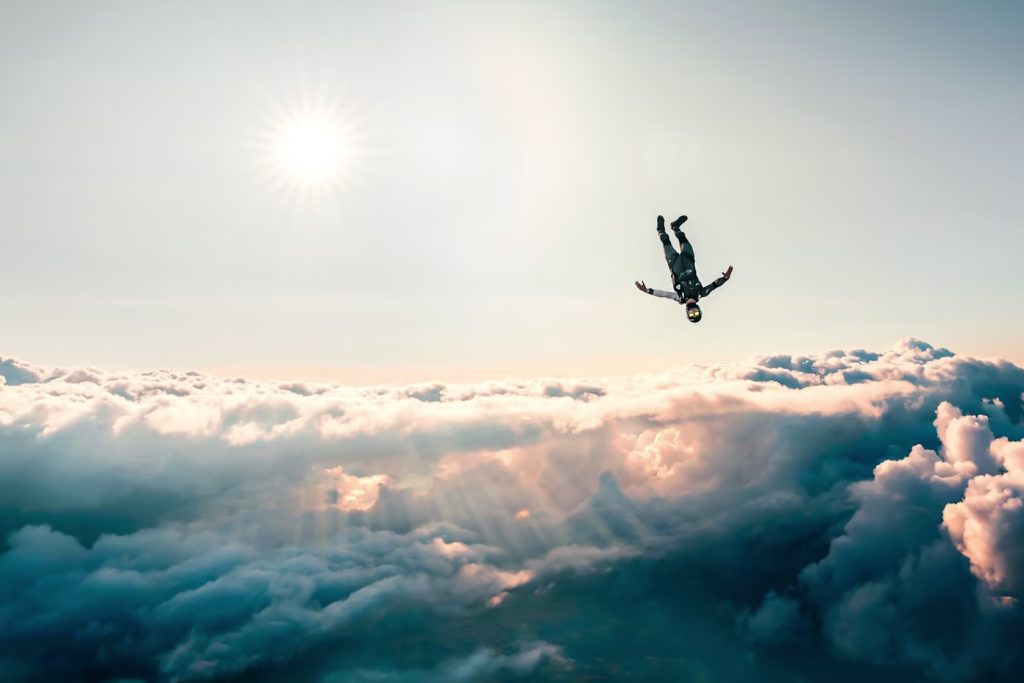
Skydiver Emil from FLUX heads down above the clouds at Sunset
Shot with Sony a7r II | Sony 24-70mm f/2.8 GM | Profoto B1X | SHUTTER SPEED: 1/1600, APERTURE: 10.0, ISO: 640

The Skydiving Team from FLUX; From Left to right: Jacob, Benjamiin, Emil

Benjamiin was the one holding the Profoto B1X at the free fall at Jesper's skydiving shoot. It isn’t normal to skydive with anything in your hands, but Benjamiin is an experienced guy, who already tried skydiving with fishing nets, fruits, and other crazy stuff

Jacob's role is to film Emil and Benjamiin from a close distance using a helmet-mounted camera while they perform. He usually does that by being flat in the air with his back facing the ground. He was also the one filming me from the air for the behind-the-scenes video for my skydiving shoot.
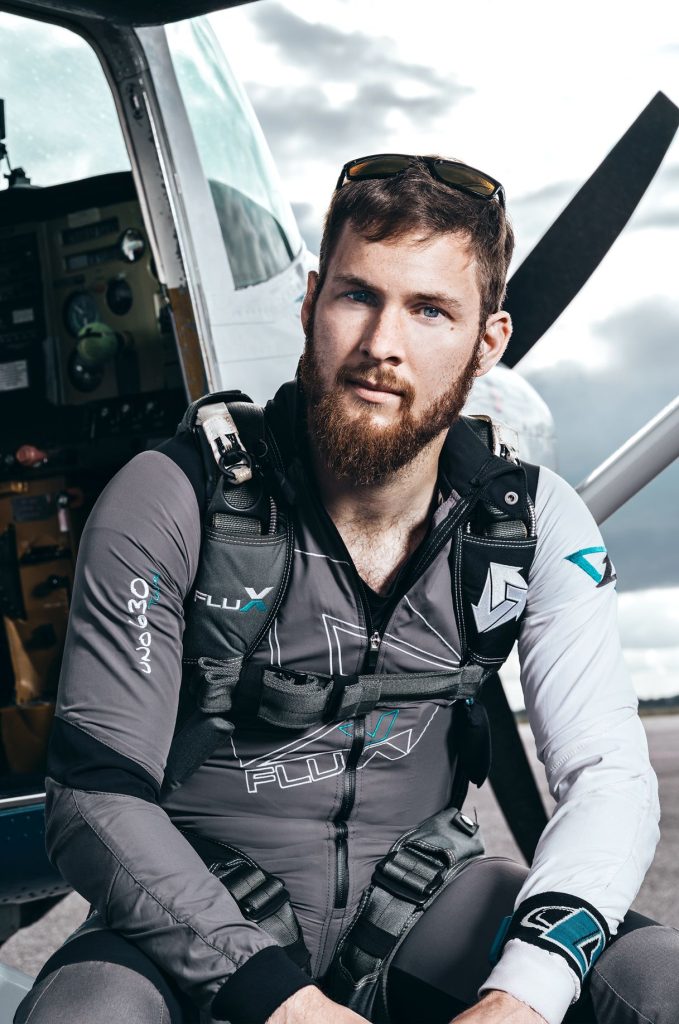
Emil was the athlete in front of the lens at Jesper's skydiving shoot. Emil recommended shooting him while he is doing a trick easily described as a front layout from the belly - a reversed Jesus rising to heaven. Jesper loved the idea because it starts a lot of thoughts at the one looking at the image when a guy is flying head first towards the ground.
[bc-component id="436" type="image"]
[bc-component id="383" type="image"]
[bc-component id="399" type="image"]
[bc-component id="437" type="image"]
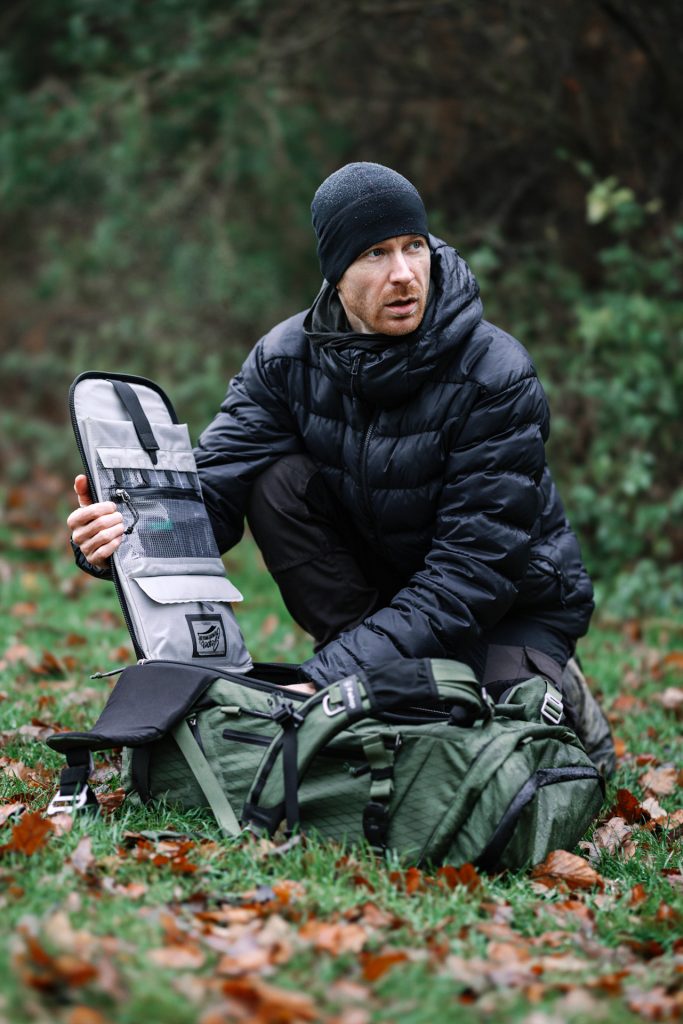
Jesper Grønnemark is renowned for his innovative approach to adventure and action sports photography, redefining the genre's conventional boundaries. See more of Jesper's work!






Discount Applied Successfully!
Your savings have been added to the cart.